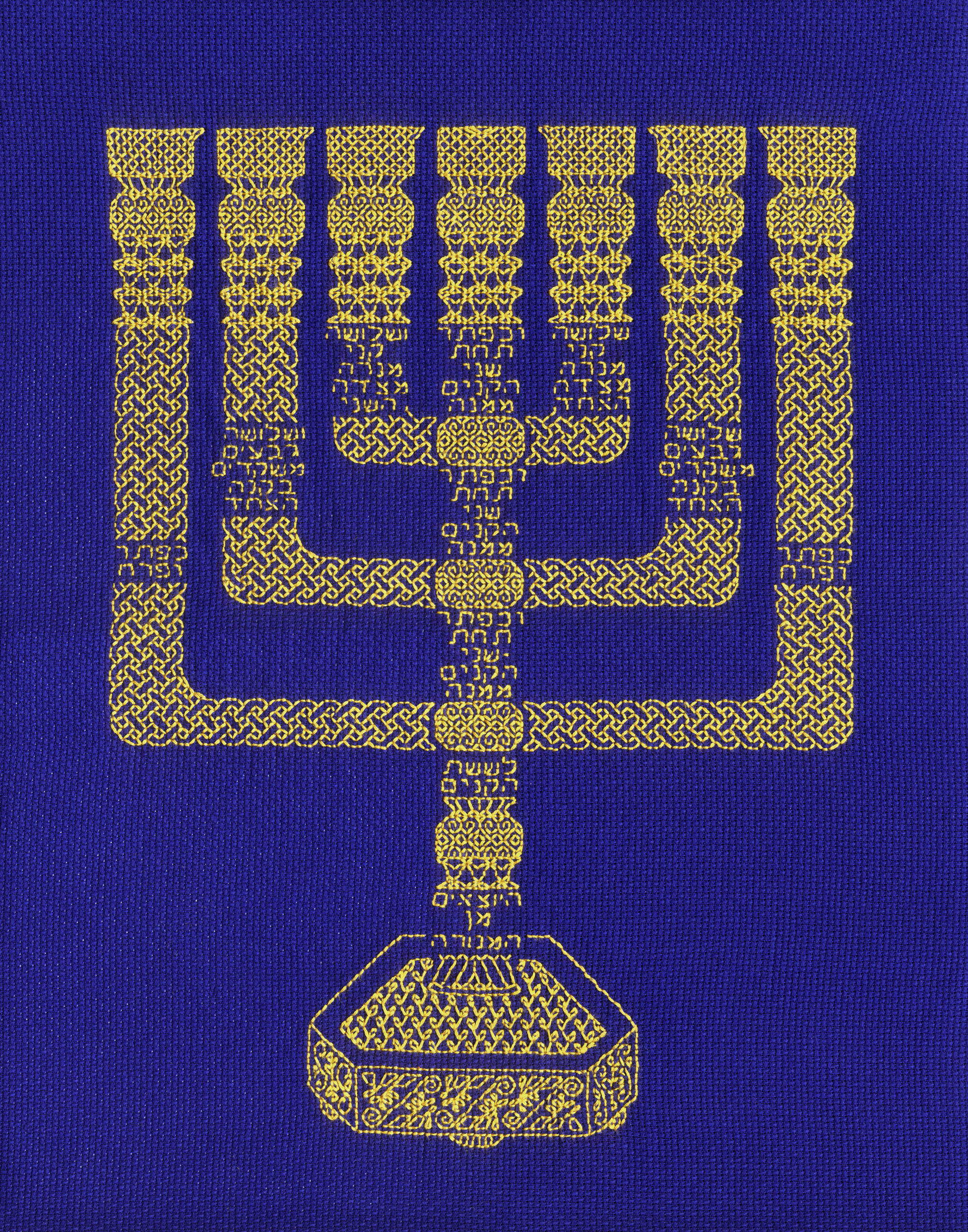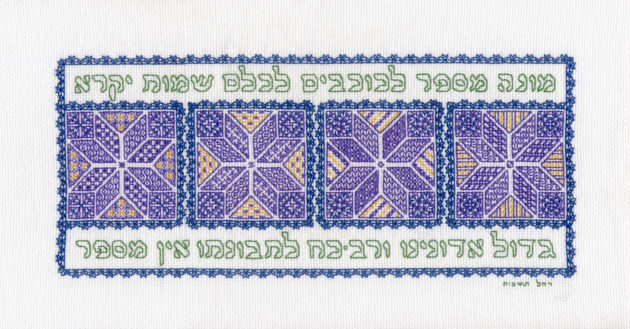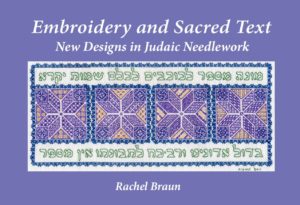
Embroidering a Jewish Life

God Counts the Stars, 2015, Rachel Braun. Scan by Philip Bookman.
Embroidery has been part of my life for over two decades; it is a core Jewish practice for me and an entry point into sacred texts. I design Judaic embroidery, starting with words from Torah or liturgy, then elucidating and interpreting the words with needle and thread. But before I discovered my embroidery passion, I’d thought about needlecraft only in limited ways.
In college, some 40 years ago, I read an article about Colonial quilt-making for an anthropology class. The author wondered why Colonial women would commit to such a painstakingly slow production process. Indeed, needlecraft is very laborious! Designing and stitching an embroidery canvas can take me easily 150 hours.
The author’s hypothesis was that usually women were responsible for repetitive production processes which had temporary outcomes, living under a tyranny of iterative tasks. Women cooked and fed their families; hunger returned anew. We laundered clothing; those garments became soiled. We cleaned; dirt arose again in every corner. Quilting, the author concluded, allowed women to participate in permanent material culture, establishing and recording their presence. Perhaps not as physical as barn-raising (and not as well paid?), but still valued.
In my adult life, I’ve become aware of the impermanence of traditional female tasks, though my responses to the feeding-laundering-cleaning conundrums of Colonial women may have differed. Raising four children, I cycled through three basic lentil recipes at dinner and taught my kids to use the washing machine. As for cleaning, my mantra became “as long as the kids don’t get cholera, the house is clean enough.” They didn’t, and it was.
 But I do embroider—vigorously, creatively, spiritually. Am I, as was alleged for our Colonial quilters, seeking immortality in material culture? That premise seems a bit specious: what we call women’s work (and what that treatise I read in college alleged was impermanent) is indeed permanent work: a long-term investment in the continuity and culture of humanity, as stabilizing as building a barn. But material culture has its purpose—useful, beautiful, necessary, communal. My framed embroidery pieces adorn the walls of my home and shul, and I dream that one day they will be passed to future descendants, or even considered museum-worthy. Just in case they aren’t, I’ve made a dive at immortality by sharing them in a book, Embroidery and Sacred Text (2017).
But I do embroider—vigorously, creatively, spiritually. Am I, as was alleged for our Colonial quilters, seeking immortality in material culture? That premise seems a bit specious: what we call women’s work (and what that treatise I read in college alleged was impermanent) is indeed permanent work: a long-term investment in the continuity and culture of humanity, as stabilizing as building a barn. But material culture has its purpose—useful, beautiful, necessary, communal. My framed embroidery pieces adorn the walls of my home and shul, and I dream that one day they will be passed to future descendants, or even considered museum-worthy. Just in case they aren’t, I’ve made a dive at immortality by sharing them in a book, Embroidery and Sacred Text (2017).
6 comments on “Embroidering a Jewish Life”
Comments are closed.




Wow. I’ve seen these works of Rachel’s and they are moving. Rachel’s explanation of the process moves me as well. Thank you.
Thank you for Rachel Braun’s blog “Embroidering a Jewish Life”. I’ve already given several of her books to artists
friends around the country. This current piece is exquisite and I hope
you will bring us
more of her work. She is an eloquent
writer, filled with knowledge, wisdom, insights,
depth and love (and quite often humor!). Lilith is the
perfect place for her writing. So thank you for
including her work.
As an aside, in
her last paragraph about Lisa Newell, of blessed memory, and her
work challenging
women’s wages, Lisa also hunted and prosecuted Nazis
and was
the attorney for workers’ rights
at local hotels. I was a notary
at the time, and in a
clandestine way, I parked my car
at the side door of one of the
downtown hotels, and one by one,
the maids snuck out, got into
my car and signed a
complaint. It was one of the
most scary and uplifting
things I had done. While I
was terrified (the women
were quite terrified
as well), Lisa
had a way of bringing us
all in to help in small
and big ways, for social justice.
I’m glad Rachel
honored Lisa
in her piece.
Thanks
you also for
Lilith and please
keep doing the
amazing work you
do.
Esther Siegel
Takoma Park, MD
Insightful and fascinating. Repetition and im/permanence will carry new meanings for me. Thank you, Rachel Braun.
This is now the 5th time that I have read this article. Upon the first reading, I felt as if I couldn’t catch my breath. There is so much rich content from the “living Torah” to “repetition and renewal” and the role of art in interpreting sacred text. It was especially nice to hear this written in a personal voice.